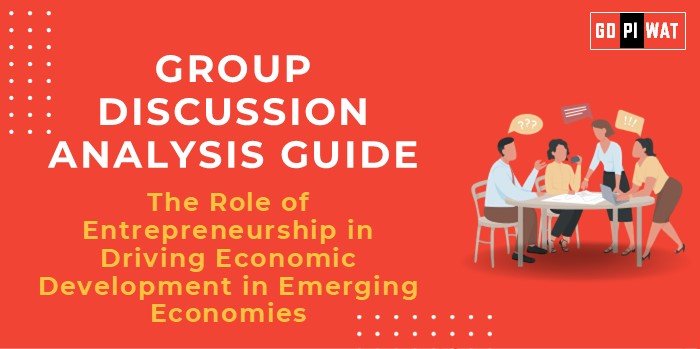📋 Group Discussion Analysis Guide: The Role of Entrepreneurship in Driving Economic Development in Emerging Economies
🌐 Introduction to the Topic
Opening Context: Entrepreneurship is a transformative force that fosters economic growth, creates employment opportunities, and promotes innovation. In emerging economies, its role is pivotal as it bridges gaps in development, accelerates structural reforms, and fosters resilience against global economic shocks.
Topic Background: Historically, entrepreneurship has been the backbone of economic revolutions. In emerging economies, it gained significant traction in the past two decades, powered by technological advancements, demographic dividends, and a global push for sustainable development. Nations like India, Brazil, and Vietnam showcase its dynamic role in fostering growth, despite socio-economic constraints.
📊 Quick Facts and Key Statistics
- 📈 Entrepreneurship Contribution to GDP: SMEs contribute 40%+ of GDP in emerging economies (World Bank, 2023), showcasing their critical economic role.
- 💼 Employment Generation: Over 50% of jobs in emerging markets are created by small businesses.
- 🦄 Startup Ecosystem Growth: India has 100+ unicorns in 2024, up from 10 in 2016, reflecting exponential growth.
- 💵 Access to Finance: $1.7 trillion microloans disbursed globally to support entrepreneurs in emerging economies (IFC, 2023).
🧑🤝🧑 Stakeholders and Their Roles
- 🏛️ Government: Provides policy support, ease of doing business reforms, and startup funding schemes.
- 🏦 Financial Institutions: Offer credit access and innovative funding mechanisms like crowdfunding and microfinance.
- 💼 Private Sector: Drives innovation, mentors startups, and creates market linkages.
- 🌐 Global Agencies: Organizations like the World Bank and UNDP promote sustainable entrepreneurship through funding and technical assistance.
🏆 Achievements and Challenges
🎯 Achievements:
- Innovation Hubs: Nations like India and Kenya have emerged as global tech hubs, nurturing thousands of startups.
- Job Creation: SMEs account for 60-70% of employment in economies like Vietnam and Nigeria.
- Inclusive Growth: Microfinance has uplifted millions from poverty, particularly women entrepreneurs.
⚠️ Challenges:
- Access to Capital: Entrepreneurs often face a funding gap, limiting scalability.
- Regulatory Barriers: Bureaucratic delays and lack of transparency hinder growth.
- Skill Gaps: Workforce skills often lag behind market needs, limiting innovation.
Global Comparisons:
• Estonia: Known for its seamless digital platforms supporting entrepreneurship.
• China: Government subsidies and market reforms have transformed it into a manufacturing and innovation giant.
Case Study: India’s Start-Up India Initiative: Launched in 2016, it has supported over 80,000 startups, creating over 7 lakh jobs.
📋 Structured Arguments for Discussion
- Supporting Stance: “Entrepreneurship is the cornerstone of economic empowerment in emerging markets.”
Example: “With startups contributing $400 billion to India’s GDP, entrepreneurship catalyzes economic transformation.” - Opposing Stance: “Challenges such as corruption and lack of infrastructure limit entrepreneurial growth.”
Example: “Nigeria’s high entrepreneurial failure rate highlights systemic barriers like weak legal systems.” - Balanced Perspective: “Entrepreneurship has tremendous potential but requires robust ecosystems for sustainability.”
💬 Effective Discussion Approaches
- 💡 Opening Approaches:
- “With SMEs contributing to 40% of emerging economies’ GDP, their role is indisputable.”
- “Countries like Estonia showcase how entrepreneurship can revolutionize national economies.”
- 💡 Counter-Argument Handling:
- “While capital remains a challenge, microfinance innovations have bridged gaps effectively, as seen in Bangladesh.”
📈 Strategic Analysis of Strengths and Weaknesses
Strengths:
- Rapid growth potential.
- Job creation.
- Adaptability to market changes.
Weaknesses:
- High failure rates.
- Limited funding.
- Skill gaps.
Opportunities:
- Global market access.
- Digital technology adoption.
- Public-private partnerships.
Threats:
- Policy instability.
- Global economic volatility.
📚 Connecting with B-School Applications
- Real-World Applications: Entrepreneurship projects in social impact, fintech, or sustainability domains.
- Sample Interview Questions:
- 🧐 “How does entrepreneurship reduce economic inequality?”
- 📘 “What role do government policies play in fostering startups?”
- Insights for B-School Students:
- Focus on scalable and sustainable business models.
- Explore partnerships for innovation.


